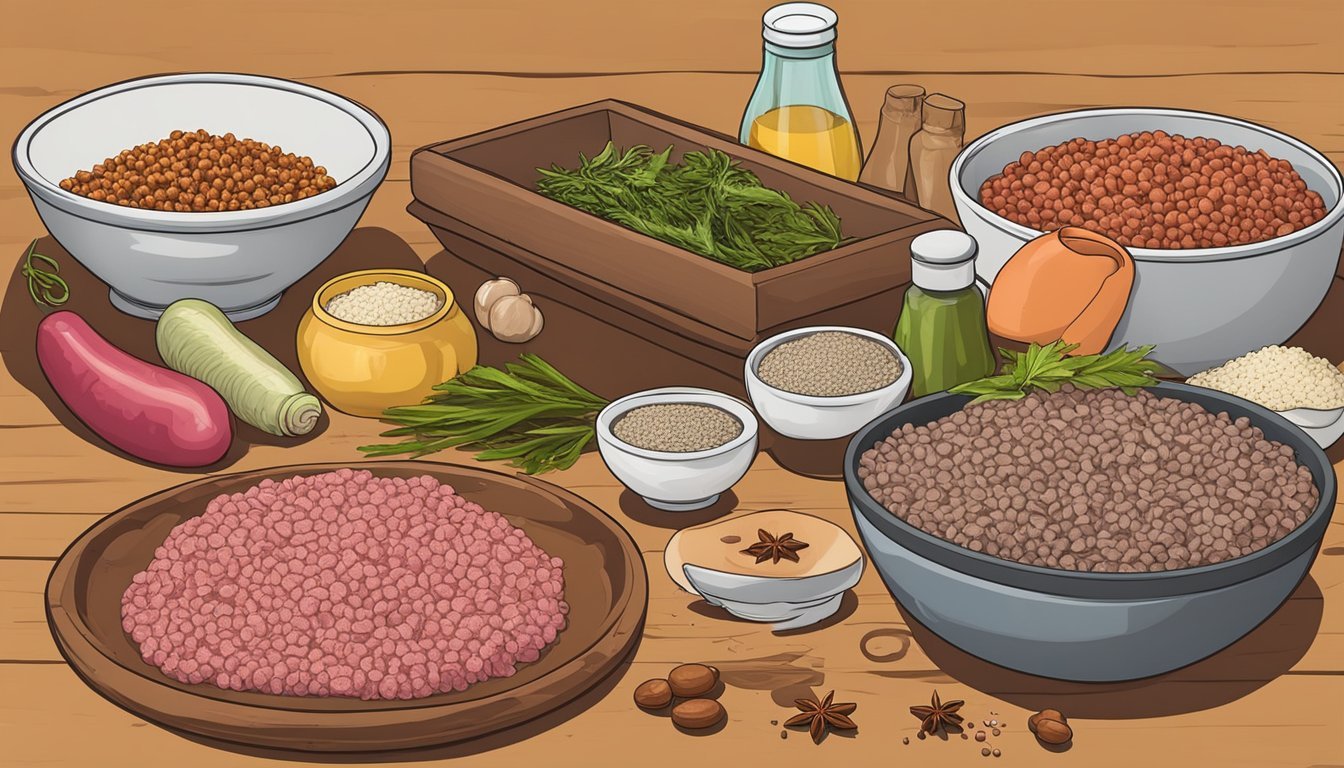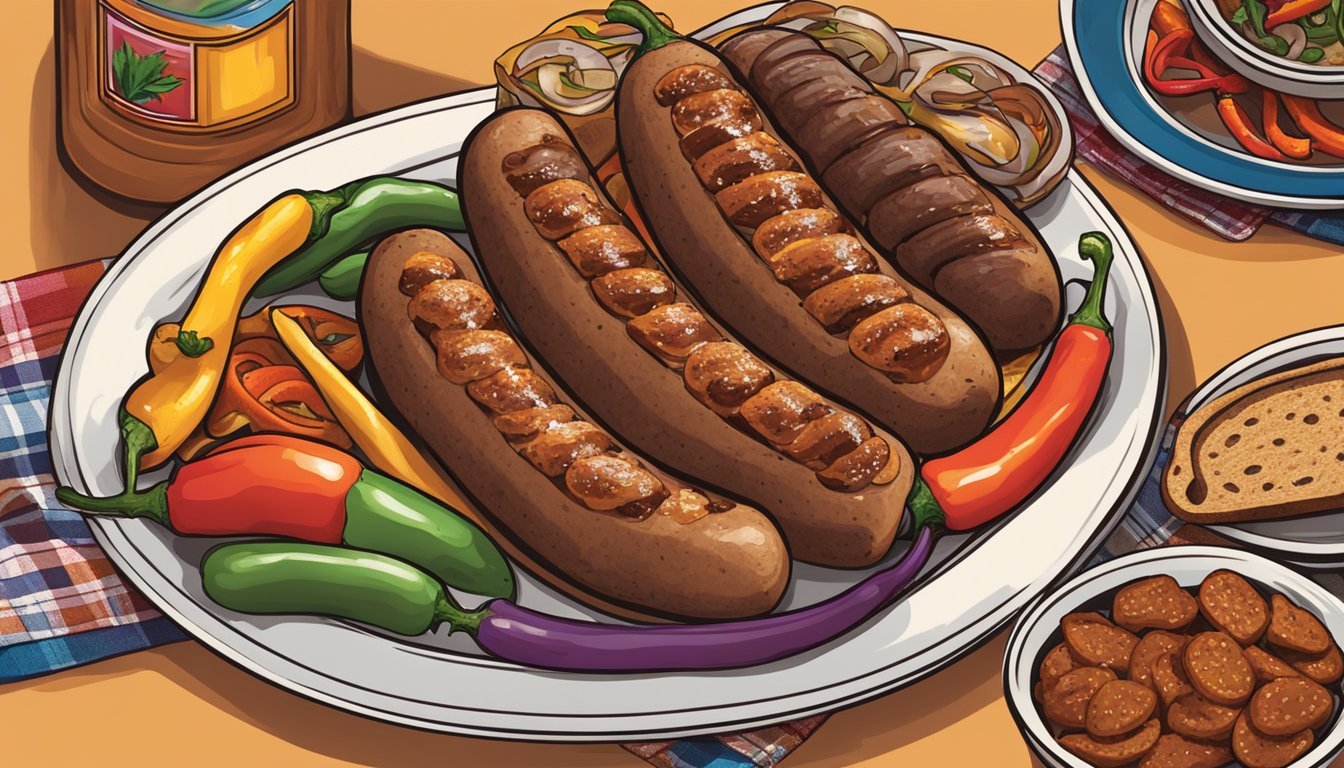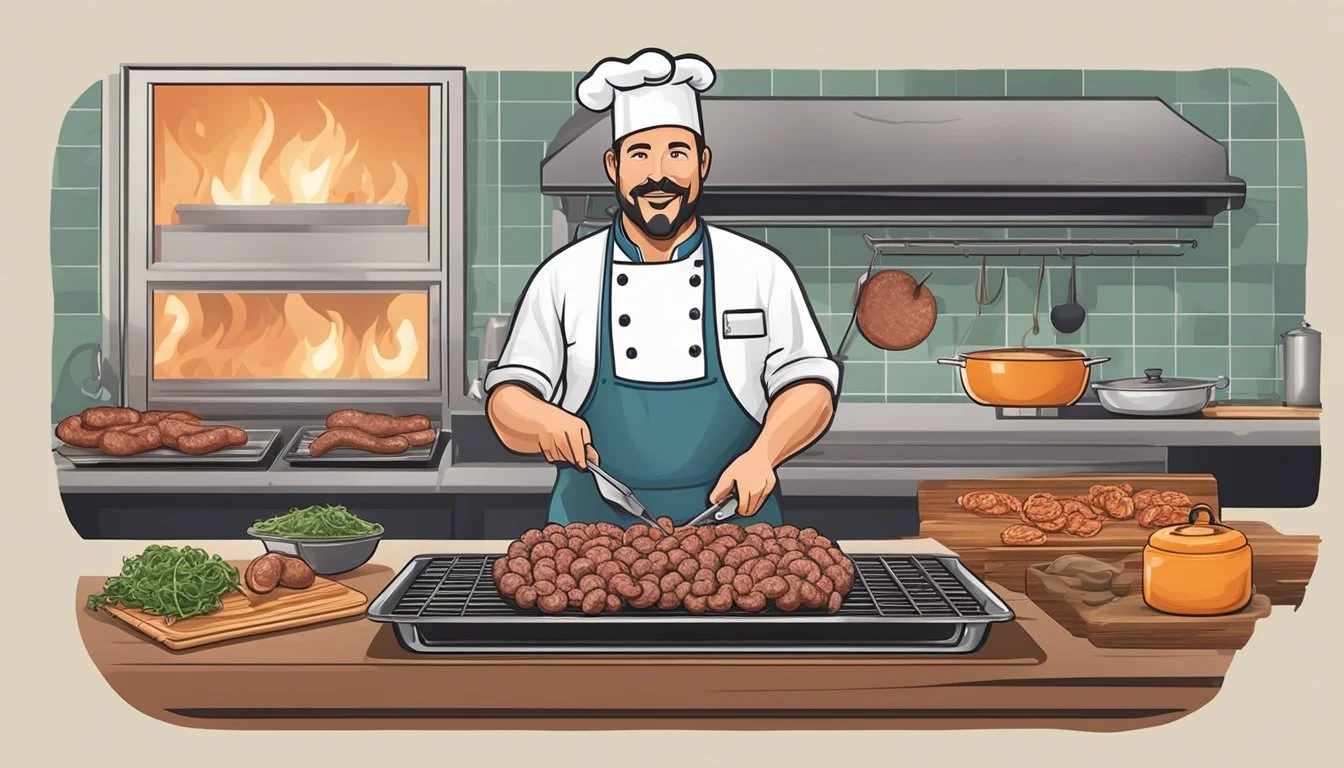How to Make Texas Hot Guts Sausage
Your Step-by-Step Guide
Texas Hot Guts is a traditional and flavorful sausage that is emblematic of Lone Star State barbecue (What wine goes well with barbecue?). Known also as Texas Hot Links, these sausages are a bold combination of beef and pork, seasoned with a robust blend of spices that typically include black pepper, garlic, paprika, and chili powder. The preparation process involves carefully selecting meats with an appropriate fat content to ensure juiciness and flavor once smoked.
The creation of Texas Hot Guts sausage requires attention to detail, from the mincing of fresh jalapeños and onions to the precise mixing of the spices. Each step contributes to the depth of flavor that these sausages are renowned for. The casings are stuffed with the seasoned meat mixture, tied off, and then smoked to imbue the links with that quintessential wood-fired taste. Upon reaching the desired internal temperature, the sausages are cooled in an ice bath to stop the cooking process, a step that also contributes to their final texture.
These sausages serve as a hearty centerpiece in a barbecue spread, encapsulating the heat and heartiness that Texas cuisine is famous for. They can be enjoyed straight off the smoker or used to add a kick of spice to a variety of dishes. With their rich history and strong flavor profile, Texas Hot Guts are more than just a meal; they are a storied tradition in America's culinary culture.
History of Texas Hot Guts
Texas hot guts are a staple in the rich tradition of Texas barbecue. Originating in the late 1800s, these sausages became synonymous with Central Texas meat markets, where butchers sought to use every part of the animal. The term "hot guts" refers to the practice of using beef and the animal's internal organs mixed with potent spices to create a robust flavor profile.
The sausage itself is distinctive for its size and heat. It is typically larger than standard varieties, and its spiciness is a hallmark, signifying the bold flavors that Texas barbecue is known for. The name 'hot guts' may be a nod to both the temperature at which the sausage is smoked and the fiery blend of spices used in its making.
These sausages are meant to be smoked slowly, which imparts a deep, smoky flavor that complements the natural taste of the beef and spices. Early iterations of hot guts were simply seasoned with salt, black pepper, and spices like cayenne to provide heat. As the popularity of these sausages grew, variations began to emerge, often including ingredients like garlic and paprika.
The immigrant populations, notably the Czech and German settlers, influenced Texas barbecue and, by extension, the evolution of hot guts. They brought their sausage-making traditions to the area, contributing to the unique flavor profiles associated with different regions of Texas. For instance, Texas-German hot guts tend to be simpler, focusing on a coarse grind of beef and a modest sprinkling of spices.
Today, Texas hot guts are a beloved element in the pantheon of Texas barbecue, with many barbecue joints and meat markets offering their own secret blends and recipes. They remain a flavorful testament to Texas' culinary history and its embrace of diverse cultural influences in its cuisine.
Selecting Ingredients
When making Texas Hot Guts sausage, the selection of ingredients is crucial for achieving the authentic flavor and texture. The right balance of meat, spices, and curing agents will create that signature taste that's beloved by barbecue enthusiasts.
Choosing the Right Meat
Beef and pork are the foundational proteins for Texas Hot Guts sausage. A mixture of 70% beef and 30% pork provides a robust flavor and ideal fat content. Opt for well-marbled cuts to ensure the sausage remains moist during smoking. The beef should be from the chuck, while pork shoulder is preferable due to its fat-to-meat ratio, which should hover around 20-30%.
Spices and Seasonings
The spice blend is what gives Texas Hot Guts their distinctive kick. A traditional spice mix includes:
Kosher salt (a must for its purity and taste)
Black pepper (generous amounts for heat)
Cayenne and paprika (for color and a mild heat)
Garlic powder and onion powder (for depth of flavor)
Mustard powder (adds complexity)
Red pepper flakes (for an additional spice layer)
Combine the spices in precise proportions to ensure consistency in each batch.
Curing and Preservatives
Cure #1, also known as pink curing salt, is essential for safe sausage making. It contains sodium nitrite and helps to prevent the growth of bacteria. The typical ratio is 1 teaspoon of Cure #1 for 5 pounds of meat. Always handle curing agents with care and measure accurately to ensure food safety.
Equipment Needed
The right equipment is crucial for making traditional Texas Hot Guts sausage, ensuring the process is efficient, and that the end product meets the highest standards of flavor and texture.
Meat Grinding Tools
To prepare the sausage mixture, one needs a reliable meat grinder. Meat grinders come in various sizes and can be either manual or electric. The grinder should have a medium plate, which is typically used for making sausage. In addition, a set of sharp knives and a cutting board will be necessary for preparing the meat and fat before grinding.
Grinder: Electric or manual to process the meat into a minced form.
Knives: Necessary for cutting meat and fat into chunks suitable for grinding.
Cutting Board: A solid surface for prepping meat.
Sausage Stuffing Equipment
After grinding, a sausage stuffer is used to fill the casings with the meat mixture. It provides greater control over the sausage’s shape and consistency compared to trying to stuff casings by hand or with makeshift tools.
Sausage Stuffer: Ensures smooth filling and consistent sausage shape.
Smoking Apparatus
For cooking Texas Hot Guts sausages, a smoker is essential. This piece of equipment should be capable of maintaining a consistent temperature for several hours and should be equipped with a reliable thermometer to monitor the sausage's internal temperature as it cooks.
Smoker: Must maintain consistent low temperatures for slow cooking the sausages.
Thermometer: To accurately monitor the internal temperature of the sausage.
Each piece of equipment plays a pivotal role in the homemade sausage-making process, resulting in delicious, authentic Texas Hot Guts sausage.
Preparing the Sausage Mix
The preparation of Texas Hot Guts sausage revolves around grinding the right meats, blending spices and curing salts, and combining everything into a homogenous mixture that needs to rest for flavors to meld.
Grinding the Meats
Begin with beef chuck and pork shoulder in equal parts, incorporating brisket trimmings for an added layer of flavor and fat content. Cut the meats into small pieces that can fit through the grinder, and ensure they are well-chilled, optimally below 34°F (1°C), to facilitate a smoother grind. Grind using a coarse plate, typically around 10mm, which will provide the desired texture for the sausage.
Mixing Spices and Curing Salts
Prepare the spice mixture using ground black pepper, paprika, garlic powder, salt, and sage for a classic Texas flavor profile. Add chile powder for some heat and minced jalapeño for an extra kick. The curing salts should be measured accurately to ensure safety and flavor—typically, a teaspoon per five pounds of meat. Mix these dry ingredients thoroughly in a separate bowl before combining with the meats.
Combining Ingredients
Transfer the ground meat into a large mixing bowl and add the spice and curing salt mixture. If the recipe calls for additional moisture, add a small amount of ice water to help bind the ingredients. Mix everything uniformly, ensuring that the temperature of the meat remains cold, preferably below 40°F (4°C). The meat should appear well-marbled with the fat and seasonings evenly distributed.
Resting the Mixture
After the ingredients are fully integrated, the sausage mixture should rest. Cover and refrigerate for at least a couple of hours, or preferably overnight. This resting phase allows the flavors to develop and the cure to work effectively, ensuring that each sausage link has a robust and consistent taste.
Stuffing and Linking
The process of stuffing and linking is vital to crafting traditional Texas Hot Guts Sausage. Precision in preparing casings, stuffing the mixture correctly, expertly linking and twisting, and managing air pockets ensures the integrity and quality of the final product.
Preparing Casings
To begin, one must select the appropriate casings for Texas Hot Guts Sausage, typically hog casings or natural casings. They should be rinsed thoroughly to remove any salt and soaked in warm water to ensure flexibility. It is critical that the casings are clean and pliable before stuffing.
Stuffing the Mixture
After the casings are prepared, the next step is to stuff them with the meat mixture. A meat grinder with a stuffing attachment is often used for this purpose. The ground meat, which includes a blend of spices and cure, should be kept cold until it's time to fill the casings. Feed the mixture into the casings slowly, being careful to avoid tearing them.
Linking and Twisting
Once the casing is filled, it's time to start the linking process. To create individual sausages, one should pinch the filled casing at the desired length and twist. It's common to alternate the direction of the twist with each link to help them stay closed.
Managing Air Pockets
During the stuffing process, air pockets can form. They should be eliminated as they can affect cooking and the final appearance of the sausage. Utilize a sausage pricker to gently puncture any air bubbles and softly compress the meat to expel the trapped air. This ensures a compact and uniformly filled sausage.
Smoking the Sausage
In crafting Texas Hot Guts Sausage, the smoking process plays a pivotal role in flavor development and texture. Smoking infuses the sausage with a distinct taste and ensures proper doneness.
Setting up the Smoker
One begins by preparing the smoker, bringing it to a stable, moderate temperature, typically between 225°F to 250°F (107°C to 121°C). Hardwood, such as hickory or oak, is chosen for its ability to impart a classic smoky flavor to the sausage links. The wood should be preheated to create a consistent smoke flow.
Controlling Temperature
Maintaining a steady temperature is crucial for evenly cooked sausage. They should avoid temperature fluctuations and should check the smoker's gauge regularly. If using a charcoal smoker, they may need to adjust the air vents to regulate the heat, while those with electric or gas smokers should set the thermostat to monitor the temperature control.
The Smoking Schedule
The typical smoking schedule for Texas Hot Guts Sausage spans several hours. They should expect to smoke the links for about 1.5 to 2 hours. However, the key is to prioritize internal temperature over time, aiming for the links to reach an internal temperature of 160°F (71°C).
Checking Internal Temperature
They must periodically check the internal temperature of the sausages using a meat thermometer, ensuring it does not exceed the target temperature to avoid overcooking. Once the desired internal temperature is achieved, they should remove the sausages from the smoker, allowing them to rest briefly. This pause permits the juices to redistribute, providing a moist, flavorful smoked sausage.
Cooling and Storing
After smoking your Texas Hot Guts sausages, proper cooling and storage are critical to maintain their quality and ensure safety. The following subsections provide guidance on these processes.
Cooling Down
Immediately after cooking, sausages should be cooled down to stop the cooking process. Plunging the sausages into ice-cold water is a proven method to reduce their temperature quickly. This not only prevents overcooking but also solidifies the fats, resulting in a stable texture. Following the ice bath, let the sausages "bloom" at room temperature for several hours, allowing flavors to develop.
Refrigerating or Freezing
To refrigerate: The sausages should be stored in the refrigerator if they are to be consumed within a few days. Place the sausages in a sealed container or wrap them tightly in plastic wrap or foil to avoid exposure to air, which can lead to drying out and flavor loss.
To freeze: For longer storage, sausages can be frozen. Wrap each sausage individually in plastic wrap and then place them in a freezer bag or wrap them in foil before freezing. This prevents freezer burn and flavor transfer between foods.
Tips for Storage
Use a reliable refrigerator or freezer with stable temperature control to store the sausages.
Label the storage containers or bags with the date to keep track of freshness.
When thawing frozen sausages, do so in the refrigerator to ensure a safe temperature is maintained throughout the process.
Serving Suggestions
When serving Texas Hot Guts sausage, presentation and pairing can greatly enhance the dining experience. With the right combination of slicing, accompanying sides, and beverage pairings, one can elevate the smoky, spicy flavors inherent in these sausages.
Slicing and Plating
To best enjoy Texas Hot Guts, one should slice the sausage into thick rounds that showcase the juicy interior. Place them strategically on a plate to allow for easy picking. Plating with intention helps maintain temperature and presents the sausages in an appetizing way, be it alongside a salad or as a stand-alone dish.
Accompaniments
The robust flavor of Texas Hot Guts pairs well with a variety of sides. A classic potato salad complements the sausage's heat with its creamy texture, while the tanginess of pickles slices through the richness. Additionally, one might consider a crisp green salad to add a refreshing balance. Serving these sausages with a side of pickles or incorporating them into a grilled vegetable platter adds layers of taste and texture.
Pairing with Beverages
A malty, cold beer acts as the perfect liquid companion to Texas Hot Guts, as it can quench the palate between spicy bites. Look for lagers or ales which offer a complementary flavor without competing with the intensity of the sausage. If one prefers a non-alcoholic option, consider iced tea or lemonade, both of which provide a refreshing counterpoint to the sausage's heat.
Food Safety and Handling
When making Texas Hot Guts Sausage, maintaining food safety and proper handling procedures ensures that the end product is both delicious and safe to consume. It is essential to monitor temperature closely throughout the process.
Meat Storage:
Refrigerate or freeze meat immediately upon purchase.
Temperature for refrigeration should be at or below 40°F (4°C).
Freezing should be at 0°F (-18°C) if not using within a couple of days.
Preparation Safety:
Keep raw meat separate from other ingredients to prevent cross-contamination.
Use clean utensils and surfaces when handling the meat.
Wash hands thoroughly before and after handling raw meat.
Grinding & Mixing:
The meat should be kept cold, ideally below 40°F (4°C), to prevent bacterial growth.
Place the bowl for grinding into a larger bowl filled with ice to maintain a safe temperature.
Sausages should be cooked to an internal temperature of 160°F (71°C) to ensure all harmful bacteria are killed.
Storage After Cooking:
Leftover sausages should be refrigerated within two hours after cooking. They can be stored in the refrigerator for up to four days or frozen for longer storage.
By following these safety measures, one can enjoy homemade Texas Hot Guts Sausage without compromising on health and safety.
Frequently Asked Questions
What are Texas Hot Guts?
Texas Hot Guts are a spicy variety of smoked sausage renowned in Texas barbecue. They usually incorporate beef, spices, and sometimes pork.
Do I need to use a cure when making Texas Hot Guts?
Yes, a cure is necessary to preserve the sausage and ensure safety during smoking. Pink curing salt is commonly used.
What type of casings should be used for Texas Hot Guts?
Natural hog casings are traditionally used for their durability and capacity to hold the spicy meat mixture.
How spicy should Texas Hot Guts be?
Spiciness is subjective, but traditionally, these sausages are quite spicy. Adjust the level of heat by adding or reducing the amount of chile powder and fresh jalapeños.
Is it necessary to use a smoker?
Smoking is a crucial step in creating authentic Texas Hot Guts, imparting flavor and cooking the sausage safely.
Ingredient Purpose Cure Preserves sausage, ensures safety Casings Holds the sausage mix, provides texture Spicy Elements Provides traditional heat and flavor
Are there any risks if I don't use a cure or follow the smoking temperatures correctly?
Yes, not using a cure or failing to maintain proper smoking temperatures can result in unsafe sausage. Always follow temperature guidelines closely.
Can I make Texas Hot Guts without a meat grinder?
While a meat grinder gives the best texture, one can hand-chop the meat, though results may vary.
Remember always to handle ingredients with care, keeping them chilled for safety, and to cook sausages to the recommended internal temperature.
Nutritional Information
Texas Hot Guts Sausage is a traditional smoked sausage known for its robust flavor profile. Nutritional content may vary depending on the specific recipe ingredients and portion sizes, but below is a general idea of what one can expect from a typical serving.
Typical Serving Size: Approximately 2 ounces (56 grams)
Nutrient Amount per Serving Calories 180-250 Total Fat 15-20g Saturated Fat 5-7g Cholesterol 40-60mg Sodium 500-700mg Total Carbs 1-2g Dietary Fiber 0-1g Sugars 0-1g Protein 10-14g
The sausage is high in protein, which contributes to muscle repair and growth. However, they are also high in fat, particularly saturated fat, which is something nutrition-conscious individuals should be aware of. Despite the high fat content, Texas Hot Guts Sausage contains essential nutrients and can be included in a balanced diet in moderation.
Sodium is another consideration, as sausages are generally high in sodium due to the salts used in curing and seasoning. Those monitoring their sodium intake should consume these sausages in limited quantities or look for recipes that use less salt.
Texas Hot Guts Sausages contain minimal carbohydrates and sugars, making them a potential food choice for low-carb diets. However, since recipes might vary, one should always check for added sugars or fillers that could affect the carbohydrate content.
It's important for individuals to consider their overall dietary needs and restrictions when consuming processed meats like Texas Hot Guts Sausage. As part of a varied diet, they can provide a satisfying and flavorful option for those who enjoy smoked meats (What wine goes well with smoked meats?).
Additional Resources
For enthusiasts eager to perfect their Texas Hot Guts Sausage recipe, a variety of resources are available that cater to different aspects of the sausage-making process.
Books and Guides:
The Sausage Making Cookbook – covers a range of techniques and recipes.
Home Production of Quality Meats and Sausages – delves into the science behind sausage making.
Online Articles and Videos:
Science of Making Sausage: For a structured approach to the process.
How to Make Texas Hot Links | Hank Shaw: Features a practical video guide.
Supplies:
Meat Grinder: Essential for processing meat. Options are available on Amazon.
Sausage Casings: Quality casings are crucial, with varieties available through culinary supply stores.
Ingredient Kits:
Spice Mixes: Pre-measured for convenience.
Available from speciality stores and online retailers, including affiliate links on Amazon.
Forums and Communities:
Enthusiasts can join forums to discuss techniques and share experiences. Examples include:
These resources serve to provide guidance and support for chefs at all levels, from beginners to those looking to refine their skills.







